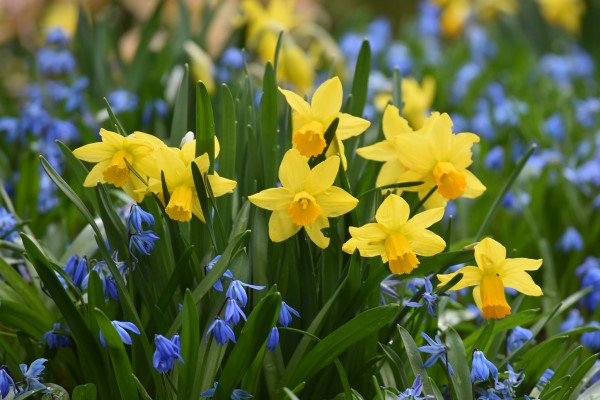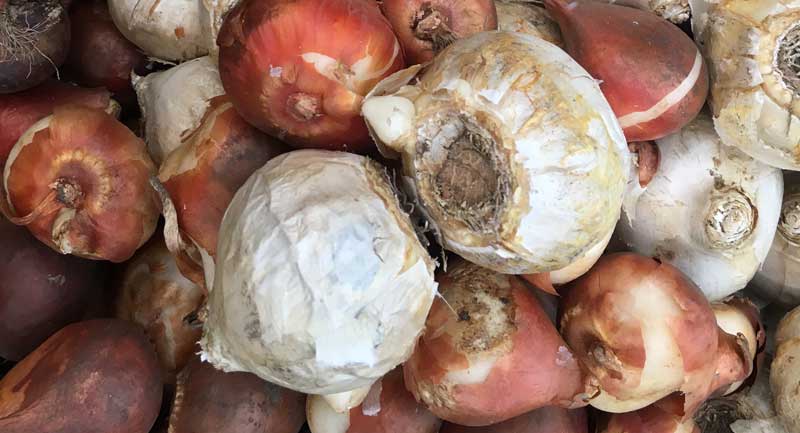While the glory of summer gardening is winding down, planting for spring is only beginning! Planting bulbs in fall takes some time, but ensures that your yard will be a colorful pollinator paradise come the first weeks of spring. So, let’s dive in to irises, alliums, tulips, and so much more!

The Perfect Bulb
With such a crowded market, it can be hard to know if you’re choosing the right bulb. Even if you know what type you want, how do you know that the ones you pick won’t end up being duds?
First, you want to make sure that you’re considering the environment you’re planting in. Critters are notorious for being bulb burglars, but there are some varieties they won’t go for.


If you’re having issues with chipmunks and squirrels, try purchasing some daffodils or hyacinths. Unlike tulips or crocuses, they aren’t edible to rodents.3 If it’s deer you’re worried about, they find the oniony smell of allium horribly unappetizing.
Avoiding Bad Bulbs
Next, make sure the bulbs you’re purchasing are of high quality. Watch out for batches of bulbs with sour smells or soft spots. These are indicators of bad bulbs that may not grow properly.
While larger bulbs are more expensive, they tend to produce more and larger blooms because they have more space to hold nutrients. So, if you’re on a budget, a normal bulb will do just fine, but if you have some spare cash, opt for the bigger bulbs.2


Time & Place
Now that you have the best bulb on the market, you’ll want to make sure that you plant it properly. Bulbs that are planted in autumn require the cool temperatures and moisture of fall for a spring bloom.
Because of that, temperatures should be around 50-55 degrees or lower. Take caution though! You shouldn’t plant your bulbs when the temperatures become freezing cold.3 To be safe, cease planting by mid-October to make sure your bulbs have enough time to establish a supportive root system before the frigid cold sets in.2


As spring awakens, your little bulbs will need at least six hours of full or partial sun to warm up and get growing. This can be under a sparce canopy of trees, dotted between wildflowers, or even in a container.
It’s also important that the space has good soil drainage to cope with the great melt of spring. If you’re worried, opt for bulbs that are better equipped to handle moisture like camassias or snowflakes.1
How to Plant
Everything hinges on this moment – finally planting your bulbs!
If your bulbs are larger, make sure that you dig your holes 6-8 inches deep to allow for proper growth. If they’re smaller, 3-4 inches will do just fine.3
It may sound obvious, but make sure that you plant your bulbs so that the roots are facing down.1 You’re already putting in all the work, and the last thing you want come spring is a big upside-down disappointment.


If you want to get fancy with it, choose bulbs that will bloom at different times in spring, and plant them in clusters. By positioning them in the same hole at different depths, you’ll have a continual rotation of stunning blooms. Still, don’t forget to mark your bulbs. Whether it’s popsicle sticks, rocks, or tags, indicating where your bulbs are will make sure you don’t weed them out or have any other unfortunate incidents.1
Lastly, make sure to give your freshly planted bulbs a good watering.1 They have a long, cold, winter ahead of them, so they need every advantage to establish before the chill sets in. Before you know it though, spring will greet you with a gorgeous yard full of vibrant flowers!
Sources
- Boeckmann, Catherine. “Fall Bulbs: Flower Bulbs to Plant in Fall.” The Old Farmer’s Almanac, 29 Mar. 2023, www.almanac.com/planting-fall-bulbs-spring-flowers.
- “Fall Is the Time to Plant Spring Flowering Bulbs.” Extension: University of Wisconsin-Madison Waukesha County, 9 Oct. 2021, www.waukeshacounty.gov/UWEX/HORT/articles/FB/.
- Johnson, Lisa. “Plant Bulbs Now for Spring Color.” Wisconsin Horticulture Division of Extension, 6 Oct. 2021, hort.extension.wisc.edu/2021/10/06/planting-spring-bulbs/.












